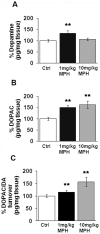Methylphenidate exposure induces dopamine neuron loss and activation of microglia in the basal ganglia of mice
- PMID: 22470460
- PMCID: PMC3312333
- DOI: 10.1371/journal.pone.0033693
Methylphenidate exposure induces dopamine neuron loss and activation of microglia in the basal ganglia of mice
Erratum in
- PLoS One. 2012;7(5): doi/10.1371/annotation/c76da2c1-ccb8-4797-94c1-359d3ceceeda
Abstract
Background: Methylphenidate (MPH) is a psychostimulant that exerts its pharmacological effects via preferential blockade of the dopamine transporter (DAT) and the norepinephrine transporter (NET), resulting in increased monoamine levels in the synapse. Clinically, methylphenidate is prescribed for the symptomatic treatment of ADHD and narcolepsy; although lately, there has been an increased incidence of its use in individuals not meeting the criteria for these disorders. MPH has also been misused as a "cognitive enhancer" and as an alternative to other psychostimulants. Here, we investigate whether chronic or acute administration of MPH in mice at either 1 mg/kg or 10 mg/kg, affects cell number and gene expression in the basal ganglia.
Methodology/principal findings: Through the use of stereological counting methods, we observed a significant reduction (∼20%) in dopamine neuron numbers in the substantia nigra pars compacta (SNpc) following chronic administration of 10 mg/kg MPH. This dosage of MPH also induced a significant increase in the number of activated microglia in the SNpc. Additionally, exposure to either 1 mg/kg or 10 mg/kg MPH increased the sensitivity of SNpc dopaminergic neurons to the parkinsonian agent 1-methyl-4-phenyl-1,2,3,6-tetrahydropyridine (MPTP). Unbiased gene screening employing Affymetrix GeneChip® HT MG-430 PM revealed changes in 115 and 54 genes in the substantia nigra (SN) of mice exposed to 1 mg/kg and 10 mg/kg MPH doses, respectively. Decreases in the mRNA levels of gdnf, dat1, vmat2, and th in the substantia nigra (SN) were observed with both acute and chronic dosing of 10 mg/kg MPH. We also found an increase in mRNA levels of the pro-inflammatory genes il-6 and tnf-α in the striatum, although these were seen only at an acute dose of 10 mg/kg and not following chronic dosing.
Conclusion: Collectively, our results suggest that chronic MPH usage in mice at doses spanning the therapeutic range in humans, especially at prolonged higher doses, has long-term neurodegenerative consequences.
Conflict of interest statement
Figures





References
-
- Arnsten AF. Stimulants: Therapeutic actions in ADHD. Neuropsychopharmacology. 2006;31:2376–2383. - PubMed
-
- Capp PK, Pearl PL, Conlon C. Methylphenidate HCl: therapy for attention deficit hyperactivity disorder. Expert Rev Neurother. 2005;5:325–331. - PubMed
-
- Hirai N, Nishino S. Recent advances in the treatment of narcolepsy. Curr Treat Options Neurol. 2011;13:437–457. - PubMed
-
- Volkow ND, Wang GJ, Fowler JS, Fischman M, Foltin R, et al. Methylphenidate and cocaine have a similar in vivo potency to block dopamine transporters in the human brain. Life Sci. 1999;65:L7–12. - PubMed
-
- Johnston LD, O'Malley PM, Bachman JG, Schulenberg JE. Monitoring the Future national survey results on drug use, 1975–2010. 2011. pp. 1–312. Volume II: College students and adults ages 19–50. The University of Michigan.
Publication types
MeSH terms
Substances
LinkOut - more resources
Full Text Sources
Molecular Biology Databases
Miscellaneous

